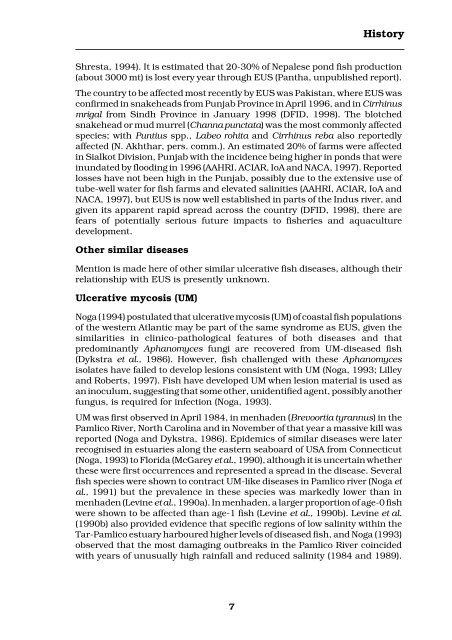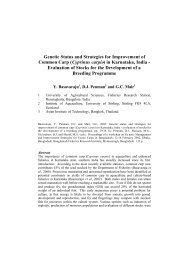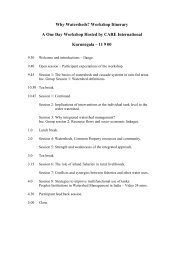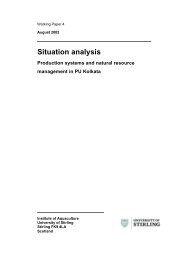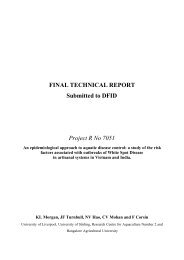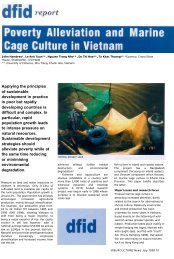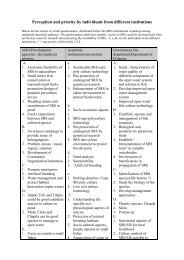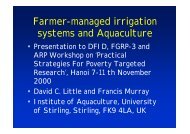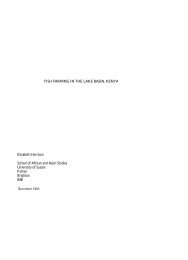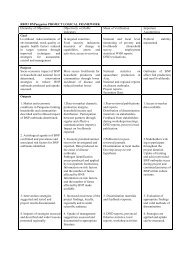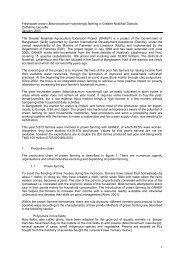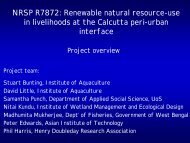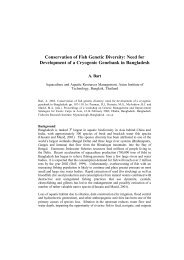<strong>Epizootic</strong> <strong>Ulcerative</strong> <strong>Syndrome</strong> (<strong>EUS</strong>) <strong>Technical</strong> <strong>Handbook</strong>suffered an outbreak in 1990 which was confirmed as <strong>EUS</strong> by histologicalexamination (Reantaso, 1991; S. Chinabut, unpublished). The occurrence of<strong>EUS</strong> in these brackishwater and marine species provided an explanation as tohow the condition may have spread between the islands. The severity ofoutbreaks has decreased since 1993. Several A. invadans isolates wererecovered from <strong>EUS</strong>-affected fish in the Philippines (Paclibare et al., 1994).A major outbreak of <strong>EUS</strong> in freshwater and estuarine fish in western Sri Lankaoccurred in December 1987, prior to any outbreaks on the subcontinentmainland (Costa and Wijeyaratne, 1989). It is suspected that the disease wasimported from Southeast Asia in shipments of infected fish, possibly ornamentalangel fish (Pterophyllum scalare), some of which were ulcerated and sufferedhigh mortalities (Balasuriya, 1994). Snakeheads with large necrotic ulcerswere the most visible sign of the disease, but tilapia, the main commercialspecies was not affected. <strong>EUS</strong> was reportedly still active in Batticaloa lagoonin 1996 (P. Vinobaba and M. Vinobaba, pers. comm.).Over the past 10 years, <strong>EUS</strong> has had a serious effect on fisheries throughoutmainland South Asia, causing losses in important capture fisheries areas anddamaging confidence in an aquaculture industry still in the early stages ofdevelopment. The disease was first reported in Chandpur district of Bangladeshin February 1988. This first outbreak lasted for 13 months during which timeit spread rapidly throughout the country, seemingly aided by the flood ofSeptember 1988 (Barua, 1994). Ulceration was observed in many wild species,predominantly snakeheads, Puntius, Clarias, Mystus and Mastacembelus.Cultured Indian major carp were also affected, although large-scale mortalitiesdue to the disease were probably restricted to fingerlings (Roberts et al., 1989).<strong>EUS</strong> prevalences subsequently declined, but there are reports that, as from1995, the severity of outbreaks is increasing in Bangladesh (G.U. Ahmed,unpublished report). In January 1993, A. invadans cultures were isolated fromfarmed Indian major carp (Labeo rohita) in NW Bangladesh and wild fish in theproductive flood plain area of NE Bangladesh.Outbreaks of <strong>EUS</strong> in India have been comprehensively reviewed (ZoologicalSociety of Assam, 1988; Jhingran and Das, 1990; National Workshop on<strong>Ulcerative</strong> Disease <strong>Syndrome</strong> in Fish, 1990; Kumar et al., 1991; ICSF, 1992;Das and Das, 1993; Mohan and Shankar, 1994). The NE Indian states werethe first to report losses in May 1988. The disease appeared to spread throughrivers, reservoirs and paddy fields to most states, affecting some Indian majorcarp farms as well. <strong>EUS</strong> had a serious impact on fish in low salinity areas ofthe rich brackishwater fisheries of Chilka Lake, Orissa in November 1990(Raman, 1992), and the reservoirs and backwaters of Kerala in June 1991(Sanjeevaghosh, 1991). Aphanomyces isolates consistent with A. invadanshave been recovered from <strong>EUS</strong>-affected fish in southern India (I. Karunasagar,pers. comm.).Bhutan and the eastern Terai of Nepal were first affected in 1989, and by 1993,<strong>EUS</strong> had spread to Himalayan valley regions including Pokhara and Kathmanduwhere cold water species, including Tor spp., were affected (Phillips, 1989;6
HistoryShresta, 1994). It is estimated that 20-30% of Nepalese pond fish production(about 3000 mt) is lost every year through <strong>EUS</strong> (Pantha, unpublished report).The country to be affected most recently by <strong>EUS</strong> was Pakistan, where <strong>EUS</strong> wasconfirmed in snakeheads from Punjab Province in April 1996, and in Cirrhinusmrigal from Sindh Province in January 1998 (DFID, 1998). The blotchedsnakehead or mud murrel (Channa punctata) was the most commonly affectedspecies; with Puntius spp., Labeo rohita and Cirrhinus reba also reportedlyaffected (N. Akhthar, pers. comm.). An estimated 20% of farms were affectedin Sialkot Division, Punjab with the incidence being higher in ponds that wereinundated by flooding in 1996 (AAHRI, ACIAR, IoA and NACA, 1997). Reportedlosses have not been high in the Punjab, possibly due to the extensive use oftube-well water for fish farms and elevated salinities (AAHRI, ACIAR, IoA andNACA, 1997), but <strong>EUS</strong> is now well established in parts of the Indus river, andgiven its apparent rapid spread across the country (DFID, 1998), there arefears of potentially serious future impacts to fisheries and aquaculturedevelopment.Other similar diseasesMention is made here of other similar ulcerative fish diseases, although theirrelationship with <strong>EUS</strong> is presently unknown.<strong>Ulcerative</strong> mycosis (UM)Noga (1994) postulated that ulcerative mycosis (UM) of coastal fish populationsof the western Atlantic may be part of the same syndrome as <strong>EUS</strong>, given thesimilarities in clinico-pathological features of both diseases and thatpredominantly Aphanomyces fungi are recovered from UM-diseased fish(Dykstra et al., 1986). However, fish challenged with these Aphanomycesisolates have failed to develop lesions consistent with UM (Noga, 1993; Lilleyand Roberts, 1997). Fish have developed UM when lesion material is used asan inoculum, suggesting that some other, unidentified agent, possibly anotherfungus, is required for infection (Noga, 1993).UM was first observed in April 1984, in menhaden (Brevoortia tyrannus) in thePamlico River, North Carolina and in November of that year a massive kill wasreported (Noga and Dykstra, 1986). Epidemics of similar diseases were laterrecognised in estuaries along the eastern seaboard of USA from Connecticut(Noga, 1993) to Florida (McGarey et al., 1990), although it is uncertain whetherthese were first occurrences and represented a spread in the disease. Severalfish species were shown to contract UM-like diseases in Pamlico river (Noga etal., 1991) but the prevalence in these species was markedly lower than inmenhaden (Levine et al., 1990a). In menhaden, a larger proportion of age-0 fishwere shown to be affected than age-1 fish (Levine et al., 1990b). Levine et al.(1990b) also provided evidence that specific regions of low salinity within theTar-Pamlico estuary harboured higher levels of diseased fish, and Noga (1993)observed that the most damaging outbreaks in the Pamlico River coincidedwith years of unusually high rainfall and reduced salinity (1984 and 1989).7
- Page 3 and 4: Epizootic Ulcerative Syndrome(EUS)T
- Page 5 and 6: Copies of this publication are avai
- Page 7 and 8: This handbook is one of a series of
- Page 9 and 10: ContentsIntroduction ..............
- Page 11 and 12: IntroductionEpizootic ulcerative sy
- Page 13 and 14: HistoryFor over 25 years, outbreaks
- Page 15: HistoryAlthough there were reports
- Page 19 and 20: Species affectedMore than 100 fish
- Page 21 and 22: Species AffectedTable 1 Species sus
- Page 23 and 24: Socio-economicsThe most severe impa
- Page 25 and 26: Public healthPrior to the initial E
- Page 27 and 28: AetiologyDiseased fish, particularl
- Page 29 and 30: AetiologyFigure 2 SporulatingAphano
- Page 31 and 32: AetiologyInvolvement of other sapro
- Page 33 and 34: Aetiologysnakehead fry died when ch
- Page 35 and 36: Environmental FactorsCurrent findin
- Page 37 and 38: Environmental FactorsSite character
- Page 39 and 40: DiagnosisCorrect diagnosis of EUS i
- Page 41 and 42: DiagnosisDiseased striped snakehead
- Page 43 and 44: EpidemiologyEpidemiology is the stu
- Page 45 and 46: EpidemiologyACID excessSULFATE RAIN
- Page 47 and 48: Control of EUSNow that research on
- Page 49 and 50: Control of EUSSurveillanceIt is imp
- Page 51 and 52: Epizootic Ulcerative Syndrome (EUS)
- Page 53 and 54: Epizootic Ulcerative Syndrome (EUS)
- Page 55 and 56: Annex 1 - Isolation of Aphanomycesi
- Page 57 and 58: Annex 2 - Count method for Aphanomy
- Page 59 and 60: Annex 2 - Count method for Aphanomy
- Page 61 and 62: Annex 2 - Count method for Aphanomy
- Page 63 and 64: Annex 3 - Maintenance of Aphanomyce
- Page 65 and 66: Annex 4 - Inducing sporulation inAp
- Page 67 and 68:
Annex 5 - Identification of saprole
- Page 69 and 70:
Annex 6 - Isolation of virusesThe i
- Page 71 and 72:
Annex 7 - Investigation of EUS outb
- Page 73 and 74:
Investigationof EUS outbreakspatter
- Page 75 and 76:
Investigationof EUS outbreaksthat s
- Page 77 and 78:
Annex 8 - EUS Sampling DatasheetsTo
- Page 79 and 80:
EUS Sampling DatasheetsEUS SAMPLING
- Page 81 and 82:
Annex 9 - Procedure for samplingfis
- Page 83 and 84:
AbbreviationsAAHRI - Aquatic Animal
- Page 85 and 86:
Glossaryachlyoid:acinar necrosis:ae
- Page 87 and 88:
Glossarylymphoid:melanomacrophagece
- Page 89 and 90:
ReferencesAAHRI, ACIAR, IoA and NAC
- Page 91 and 92:
ReferencesCallinan, R.B., Paclibare
- Page 93 and 94:
ReferencesFrerichs, G.N., Millar, S
- Page 95 and 96:
ReferencesLilley, J.H. and Frerichs
- Page 97 and 98:
ReferencesNoga, E.J., Wright, J.F.,
- Page 99 and 100:
ReferencesRodgers, L.J. and Burke,
- Page 101 and 102:
ReferencesViswanath, T.S., Mohan, C


